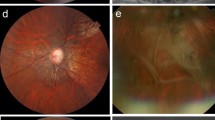Abstract
The aim was to evaluate alterations in Visual-Evoked Potentials (VEP) and Electroretinogram (ERG) and discover whether these tests are useful for determining residual visual acuity in cases where a patient is unable to collaborate. Flash and, when possible, Transient Pattern Reversal Visual-Evoked Potentials and Maximal Response ERG were recorded in 8 children (under three years old) affected by different aspects of optic nerve coloboma. None of them had visual acuity evaluated because of poor collaboration. All examinations were carried out using skin electrodes. Amplitude of the a and b component of ERG, amplitude, morphology and latency of the major components of Flash VEP and amplitude and latency of P100 Pattern Reversal VEP were evaluated. Four of the patients were examined three years later and visual acuity was compared with the previous electrofunctional results. Alterations in ERG were found only in the case of significant retinal anomalies (great coloboma, retinal detachment), huge alterations were found in both Flash VEP and in Pattern Reversal VEP. The retrospective study of VEP traces and visual acuity showed a good correlation between electrofunctional data and visual capability. Electrofucntional examinations can identify important conductive retinocortical anomalies. The possibility of correlating electrophysiological results with residual visual acuity is important for rehabilitative management in such optic disc malformations.
Similar content being viewed by others
References
Weiss A. Ocular Malformations. In: Greenwald MJ, Pediatrics ophthalmology. Ophthalmol Clin North Am 1990; 3, 2: 131-148.
Giuffre G. Colobomas of the optic area. Metab Pediatr Syst Ophthalmol 1989; 12, 4: 100-102.
Apple DJ. New aspects of colobomas and optic nerve anomalies. In: Kivlin J. D., Developmental abnormalities of the eye. Little, Brown and Co., Boston. Int. Ophthalmol Clin 1984; 24, 1: 109-121.
Bane MC, Birch EE. VEP acuity, FPL acuity and visual behavior of visually impaired children. J Pediatr Ophthal Strabismus 1992; 29, 4: 202-209.
Gottlob I, Wizov SS, Odom JV, Reinecke RD. Predicting optotype visual acuity by swept spatial visual-evoked potentials. Clin Vis Sci 1993; 8, 5: 417-423.
Granet DB, Hertle RW, Quinn GE, Breton M. The visual-evoked response in infants with central visual impairment. Am J Ophthalmol, 1993; 116/4: 437-443.
Borchet M, McCulloch D, Rother C, Stout AU. Clinical assessment, optic disc measurements and visual-evoked potential in optic nerve hypoplasia. Am J Ophthalmol 1995 120/5: 605-612.
Author information
Authors and Affiliations
Rights and permissions
About this article
Cite this article
Tormene, A.P., Riva, C. Electroretinogram and visual-evoked potentials in children with optic nerve coloboma. Doc Ophthalmol 96, 347–354 (1998). https://doi.org/10.1023/A:1001720210698
Issue Date:
DOI: https://doi.org/10.1023/A:1001720210698




